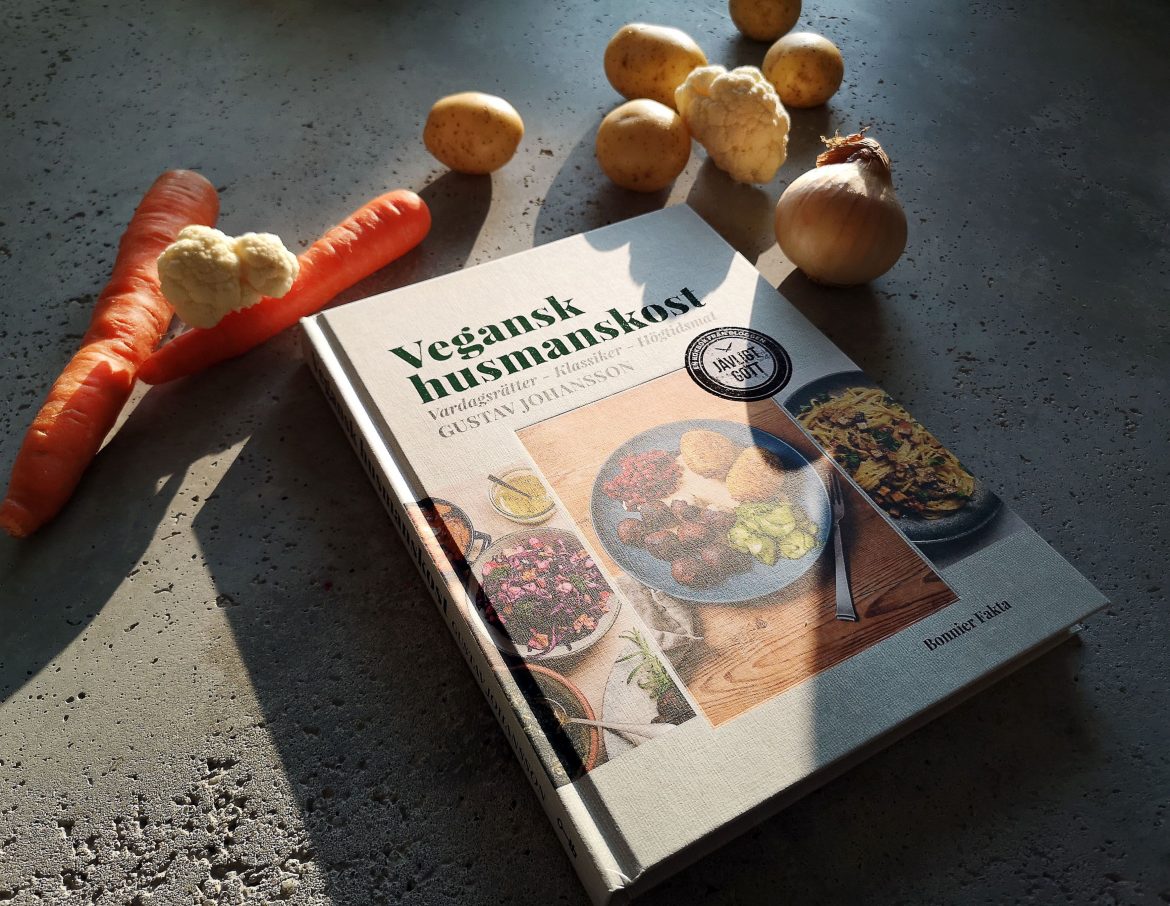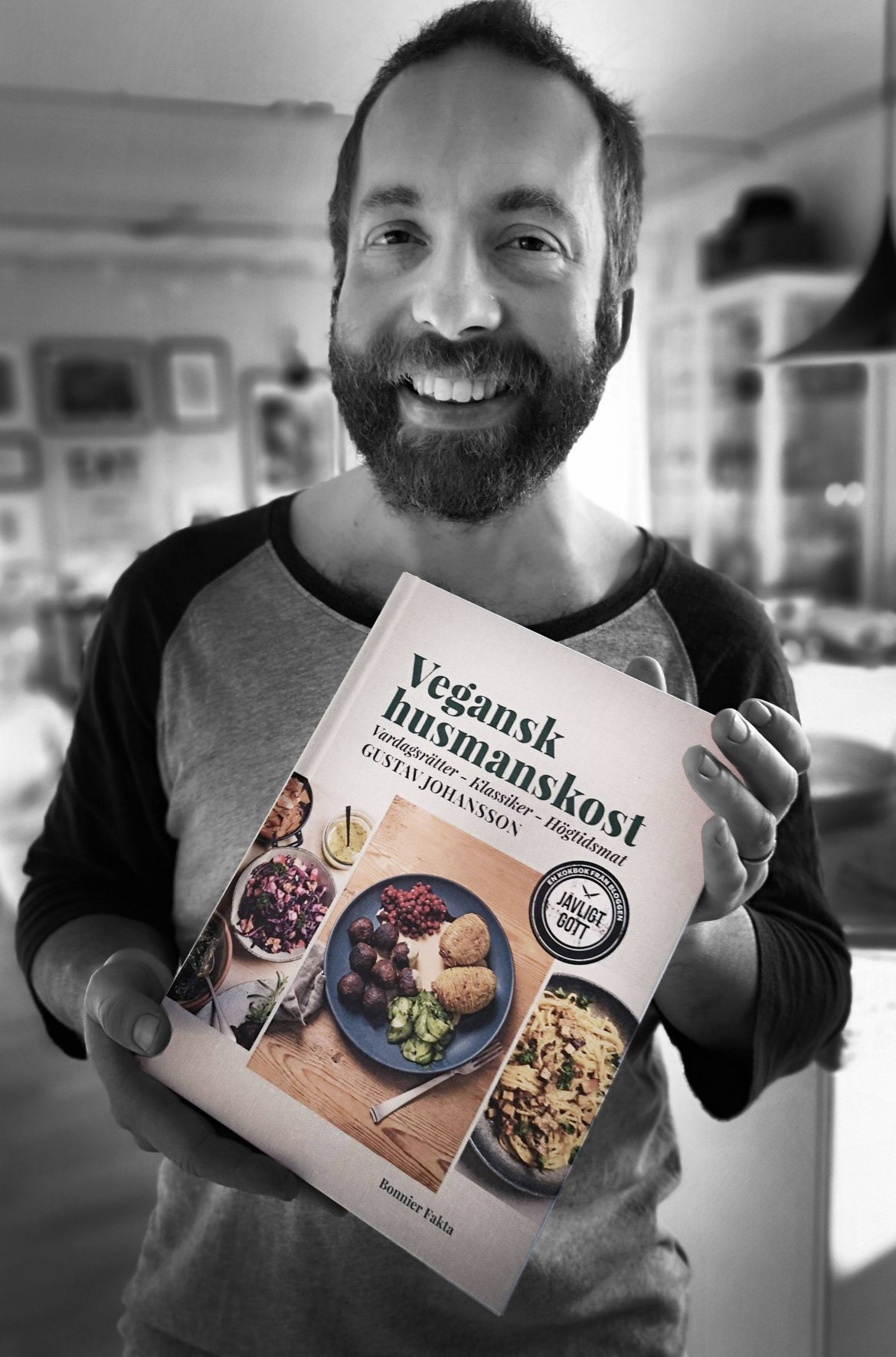TL;DR
Gustav Johansson's "Jävligt Gott" cookbook offers a pragmatic approach to veganism, focusing on reimagining classic Swedish home cooking with plant-based ingredients. While the vintage aesthetic might be a bit muted, the recipes themselves are clear and aim to make veganism accessible, even for those transitioning gradually. The book covers everyday meals, traditional Swedish dishes, and holiday fare, with highlights like vegan bacon and glazed root celery. A minor critique is the lack of recipes for those avoiding processed meat substitutes. If you're curious about delicious, familiar vegan comfort food, this book is worth a closer look!
I’ve followed the blog “Jävligt Gott” periodically for several years and was intrigued to learn of their forthcoming cookbook. For those unfamiliar, this blog focuses on vegan food and cooking.
Gustav Johansson, the creative force behind the blog, not only shares original recipes and cooking techniques, but also reports on current events within the vegan culinary landscape.
I appreciate the blog’s inclusive approach, which avoids condescension towards meat-eaters and instead presents an alternative perspective. Gustav isn’t rigidly dogmatic about veganism; he offers guidance on substituting ingredients, such as suggesting alternatives to vegan cheese for those who prefer traditional dairy. This accommodating attitude is commendable.

I won’t delve into the complexities of the meat industry and its environmental impact, except to acknowledge that plant-based diets are increasingly becoming essential. While insects have been proposed (and are being explored) as a future protein source, they may not appeal to all palates, and are certainly not vegan.
It’s widely acknowledged that reducing meat consumption is crucial for personal health, animal welfare, and the sustainability of our planet.
However, I advocate for balance and believe that adopting a fully vegan (or even vegetarian) lifestyle doesn’t need to happen instantaneously, or at all. Gustav echoes this sentiment in his book, suggesting a pragmatic approach. Prioritizing plant-based meals for the majority of the time, while occasionally indulging in a steak, is preferable to avoiding plant-based foods entirely.
This gradual transition is a sensible approach. As the saying goes, “Rome wasn’t built in a day“.
If you do consume meat, I advocate for sourcing it from local, organic, and Swedish producers.
Now, returning to the book itself.
My initial impression upon receiving the book was slightly misleading. The cover’s muted colors and retro aesthetic evoked the early 1980s, differing from what I anticipated for a 2019 cookbook.
However, as the adage states, “Never judge a book by its cover.” It took me longer than I’d like to admit to realize that the aged aesthetic of the photographs was deliberate. The book focuses on classic Swedish home cooking, reimagined with vegan ingredients. Many, if not all, of the recipes are vegan adaptations of dishes the author enjoyed during his upbringing. The photographs maintain this vintage style, which, while understandable, can appear somewhat muted. The food presentation is traditional, effectively mimicking the original dishes and potentially deceiving many observers. However, the subdued color palette somewhat diminishes the visual appeal of the food.
Vegansk husmanskost (Vegan Home Cooking) begins with a worthwhile preface, followed by the author’s account of his culinary journey, which didn’t initially revolve around veganism. This is a common trajectory, particularly for those born in the 1980s and 1990s.
One particular anecdote resonated with me, recounting a conversation with his father regarding traffic management. The discussion centered on the human tendency to prioritize convenience, often at the expense of what is ethically sound. He then applies this concept to vegan cooking, arguing that encouraging wider adoption of plant-based diets necessitates making it easier to eat green, rather than making it harder to eat meat.
The author proceeds to offer practical advice on embarking on a vegan journey. He reviews a range of contemporary ingredients, highlighting the increasing variety and availability in recent years. This is particularly beneficial for those new to vegan cooking. He also explores flavor pairings and, crucially, emphasizes the importance of texture.
The book also provides guidance on achieving optimal egg flavors and crafting vegan cream cheese. Furthermore, it presents several alternatives for replicating the taste and texture of meat, including textured vegetable protein, minced vegetable protein, and formable minced vegetable protein.
However, I have a minor critique. Where are the recipes and guidance for those who prefer to avoid processed or semi-prepared products? I generally prefer to prepare my own vegan mince and veggie burgers when cooking vegetarian or vegan meals.
While I understand the appeal of convenience (as the author himself mentioned in the earlier anecdote), what about those who prefer to avoid ready-made ingredients?
I would have appreciated an alternative to store-bought mince in the taco recipe, such as a mixture of walnuts, cauliflower, soy, and spices baked in the oven. Similarly, for the meatballs, a variant based on almonds and chickpeas would have been a welcome addition, as they are easy to shape and offer a delicious flavor profile. This is merely a suggestion.
One might ask: Why must vegan dishes imitate meat-based dishes? They don’t necessarily have to, but this book specifically focuses on recreating familiar home cooking classics in a vegan format. Humans are creatures of habit, and for many (particularly those of my generation), these are the flavors and dishes we associate with our upbringing.

The recipes are categorized into three sections: everyday food, classic home cooking, and holiday food.
The everyday food section features recipes for dishes commonly enjoyed on a Friday night, such as pasta Bolognese, fish fingers, pancakes, and tacos. This section includes 15 familiar recipes that most people have likely encountered. The selection is well-rounded, the recipes are clearly written, and the meat substitutes are generally effective. I particularly recommend the fejkon (vegan bacon), which boasts a pleasant smoky flavor and satisfying texture. While I’ve previously made fejkon from carrots, tofu proves to be an excellent alternative.
One might question the terminology used, such as “meatballs,” “fish fingers,” and “bacon,” given the absence of meat or fish. While I initially had reservations, I acknowledge that these names clearly indicate the intended mimicry. Furthermore, terms like “steak,” “patty,” or “sausage” refer to the shape of the dish, rather than its content.
Moving on to “classic home cooking,” this section showcases recipes that represent Swedish culinary heritage. Dishes include cabbage dolmas, kroppkakor (potato dumplings), kalops (beef stew), dillkött (dill stew), and, of course, smörgåstårta (sandwich cake)! While these dishes may seem traditional, they are often underrated. When properly prepared, they offer flavorful and hearty meals, representing a significant aspect of Swedish culture, now presented in a new, vegan-friendly form.
Finally, we arrive at holiday food. What plant-based options are suitable for a green Christmas or Midsummer celebration? This section offers several inspiring recipes for festive occasions. The glazed root celery presents an excellent alternative to traditional Christmas ham. I prepared it last Christmas and found it delicious. However, I am uncertain how it fares the following day on crispbread with mustard – perhaps someone else can comment on that?
One section I find lacking is desserts. While some may perceive desserts as being inherently unhealthy or non-vegan, it’s important to remember that vegan does not automatically equate to healthy. Many items, such as chips, french fries, and Coca-Cola, are vegan but certainly not health foods.
Admittedly, traditional Swedish desserts from the 1980s are not particularly exciting or flavorful. Pear halves with mint chocolate, anyone? However, other classics, such as apple pie, cheesecake, and the Christmas dessert rice á la Malta, could benefit from a vegan revival.
Perhaps in the next book?

